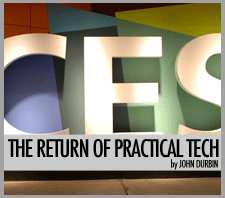The Marketing Implications of CES 2010
Posted by Eric Bee | January 15, 2010
The state of modern technology can be summed up by the TV in my hotel room. It was a 50″ flatscreen LCD, mounted beautifully into a wooden console, but displaying a blocky, stretched standard definition signal. Despite the investment made into purchasing these top-tier TVs, the hotel wasn’t using them to their full, high-definition potential. At CES, one could walk through miles of glistening technology, showcasing 3D images, immersive soundscapes, and internet-enabled everything, but to what purpose? Are consumers so over HDTV that they need a third-dimension? Is the world ready for an internet-enabled alarm clock? If the SD broadcast of ESPN greeting me every morning was any indication, the answer might be no.
Not to say that consumers are outright rejecting technological advancement, they’re just not seeing the benefits of such things in their everyday lives. That said, the marketing implications below are less about the gear and more about how marketers could utilize this tech to engage consumers in whole new ways. Through devices like eReaders, services like online storefronts, and the convergence of digital services into the living room, marketers are going to have a lot of opportunity to do groundbreaking work and, perhaps, change consumer perception about these technological breakthroughs. Then, maybe, I can get an HD signal in my hotel room for CES 2011.

CES is closed to the public, despite being a show about “consumer” electronics. More often than not, the tech showcased on the floor will not end up in homes. Things like the 154″ television and robots are built to celebrate technology, but not the consumer. Products that have a definable consumer benefit, however, catch on quickly and build hype around their possibilities. Gear like the Boxee, which brings content from the computer to the TV screen in an easy way, or the OnStar Mobile Experience, which lets smartphones communicate with a car’s onboard computer, weren’t buried under technical specs or buzzwords like “innovation” or “futuristic.” Instead, these products were presented by explicitly showing off how they work and why someone would want to use them in a straightforward manner.
The most difficult question asked of booth reps was often, “Why?” In a sea of high-definition displays, black boxes, 3D goggles, and touch screens, the devices that stand out are those that place the consumer first; the ones that showcase exactly how they will change lives for the better. The hype for Onstar Mobile and Boxee are more tangible and magnified coming out of the show than other goods because of their consumer-facing marketing and overall attitude. They both answered the “Why?” question without big, loud numbers, figures, or a talking robot.

Nearly every major electronic manufacturer had their own idea of what an eReader should be. Amazon’s Kindle saw imitators on every corner, while the Skiff brought back the feel of a newspaper with a large metal-foil display. Despite the flood, it bodes well for the written word, heralding a revolution in how people consume and tell stories for the foreseeable future. Right now, an eReader is pretty simple: a digital version of the printed page that brings the ease of e-commerce to a personal library. While the written word hasn’t shifted over entirely to an advanced state, eReaders present exciting possibilities for storytelling in the digital age. Devices that playback audio, video, and display advanced, shifting graphics bode well for the creators that take advantage of the medium. Much in the way streaming video shifted how stories are told on the web, these small, creative additions will change the way printed work is consumed and how its stories are told. Marketing mavens should latch onto these possibilities sooner than later, as they will first be exploited by traditional media outlets attempting to reinvent themselves. Given the vast majority of marketers have traditional media ties, the opportunities that come form piggybacking on this shift will yield immediate first-mover advantages.

Wandering through the South Hall, show-goers were greeted by an eclectic group of booths showcasing smaller-scale innovation, usually taking established tech and making it cheaper, sleeker, or specific to interests like karaoke or massage. People may not need a USB-powered desk vacuum or a giant rabbit that reads e-mail, but they wouldn’t turn down an opportunity to pick one up on the cheap. With web retailers putting a spotlight on these items as one-a-day sales or discount alternatives to more expensive, name-brand items, folks are more apt to purchase gear like this than ever before.
To this point, popular e-retailer Woot.com built a booth right in the middle of the South Hall fray. They weren’t there to showcase the website, but to secure distribution deals for these alternative electronic goods and to offer these smaller companies much needed exposure. Despite CES being a traditional hotbed for big-box stores setting up deals with consumer electronics’ major players, the rise of e-commerce has led to smaller-scale deals being cut right on the show floor. Typically, the South Hall has been a collection of items to be forgotten, but e-commerce is ensuring we’ll be seeing this tech offered online for an extended period.
We’ve already seen how the consumer shift to e-commerce has affected retail through long-tail economics, but marketers should be very aware of the advantages offered by digital retail innovation. Woot’s one-a-day sales model works for them because of the product lineup they offer, which doesn’t compete directly with analog retail. Swoopo.com auctioning off name-brand electronics while lining their own pockets through an innovative subscription model is another great example of the changing nature of e-commerce. With these new retail strategies, marketers should experiment with the ideas presented by these companies, whether it’s introducing new product for a limited time, testing the price point through quick sales or auctions, or using customer feedback to gauge a product’s value and usage instantly.
Finally, e-commerce isn’t limited to independent retailers. Companies are forming their own marketplaces to sell goods directly to their customers, ala the Apple App Store model. Samsung took this marketplace idea and integrated an online application into their newer televisions, giving consumers online-enabled games to purchase and play on their televisions, sans console. The introduction of marketplaces directly into devices like televisions and mobile phones also offers fertile ground for brands and advertisers to reach out to consumers. It’s an environment where brands have equal footing regardless of size or clout, something brick and mortar shelf space doesn’t allow. For brands investing early in this space, they can quickly become a leader in this environment, and potentially even monetize the “marketing” they’re delivering in these environments. Just look at Kraft’s iPhone app, which did something early and did it well in the App Store.

The consumer electronic battleground has always been in the living room. Every year, CES changes the face of the living room, whether through new ways to display content or by fitting the functionality of a computer into the entertainment center. This year was no different, albeit the devices have shifted from routers and wiring solutions to content integrations into existing technology. Gaming consoles are quickly evolving into a “trojan horse” to sneak new experiences onto your TV screen and newer HDTVs are eliminating the middleman by integrating widgets and apps.
Microsoft’s Xbox finally showed off its IPTV integration of Mediaroom 2.0 with AT&T’s U-Verse service, letting the console work as a game system, DVD player, and cable box. With the console now offering TV alongside Facebook, Twitter, and LastFM, Microsoft is making a play to be the only device in the living room. Digital tools are continuing to make their way directly into televisions as well, whether through 3rd-party devices like the aforementioned Boxee, or the direct integration of programs like Skype.
As technology converges into the living room from all points of the home, the media opportunities grow exponentially. The living room TV is no longer the territory of a :30 second spot, but a showcase for more pronounced programs like casual gameplay, marketplace microtransactions, or social media integrations. A one-box, one-screen future is on the horizon and marketers should be ready to take advantage of the freedoms that come with this convergence. It’s not an easy task, as the multiple formats, widgets, apps, and other internet fun can put too much media at marketers’ disposal. With all this innovation, marketers will need to work to find out the right fit for their idea, whether that’s an integrated play across multiple mediums on these advanced televisions or just a single app that offers more to the experience. True innovation will come from the programs that figure out how consumers are playing between what’s broadcast on the airwaves and what’s coming through their network. The days of creating content that works on one or the other are coming to a close. The question of whether this makes this simpler or more complicated for any given marketer depends on how well they organize their efforts.

All in all, new technologies and the business around them still remain an exciting space for marketers to work within. When looking back at CES shows of the past, devices we take for granted now, like Microsoft’s SYNC program or the iPod ,were big risks for both retailers and marketers. Now, entire industries have sprouted up around both of these technologies.
The successful brands in new spaces won’t be the ones who get there first. The real success will sprout from understanding the behaviors behind these new technologies and how they can be utilized to carve out a unique idea. Learning about a product or new trend in tech and experimenting with their possibilities early carries a decided advantage. By understanding the behavior behind the device, the “Why?” of technology, everything from eReaders to converged devices will make more sense to brands, marketers, and ultimately, the consumer.
Thanks to Saneel Radia, Tim Harris, Matt Story, and John Rafferty for contributing to this article.Leave a Comment
RSS feed for comments on this post · TrackBack URI

